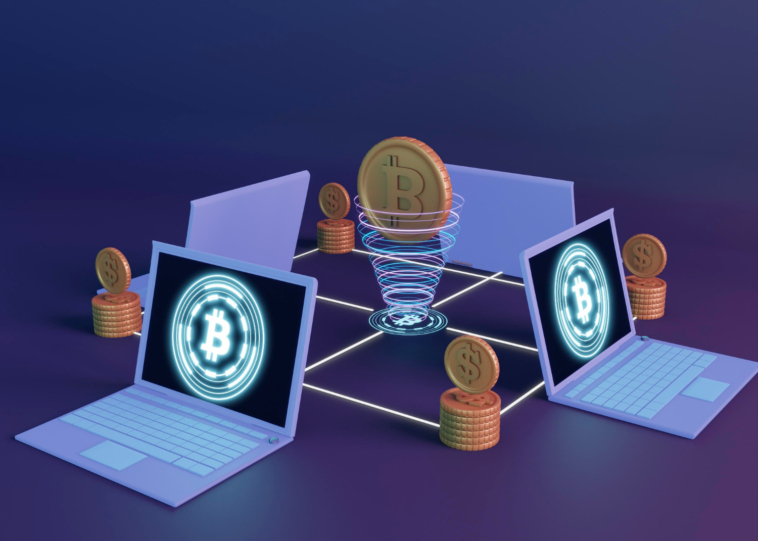Cryptocurrency mining is the process by which networks of specialized computers generate and release new coins on a blockchain network, helping prevent double-spending of digital currencies.
Miners solve complex mathematical puzzles to verify transactions and add them to the decentralized blockchain ledger, earning them rewards with newly minted cryptocurrency.
What is it?
Cryptocurrency mining is the process of creating new digital “coins.” However, it serves another purpose as well: validating the legitimacy of cryptocurrency transactions on a network’s blockchain. Miners earn rewards when they validate a block of transactions, with proportionate rewards distributed according to their contribution in computing power.
Many cryptocurrencies utilize a proof-of-work (PoW) validation mechanism, while some networks utilize another model. Some use what’s known as a proof-of-stake system, where miners stake their own cryptocurrency in exchange for validation of new transactions and updating the blockchain.
No matter the reward, miner’s efforts are essential for maintaining the security and stability of cryptocurrency networks. Proof-of-Work (PoW) cryptocurrencies like Bitcoin use powerful computer systems to solve complex mathematical puzzles and verify blocks of transactions added onto a decentralized ledger known as the blockchain.
To be successful at mining, you need a powerful computing system and access to affordable electricity. The exact hardware requirements will vary depending on the currency you intend to mine; however, typically this includes a computer, mining rig, and an online mining pool.
Mining cryptocurrency can be a time-consuming and costly endeavor, plus the electricity costs involved can be substantial. Before beginning this endeavor, take into account all of your available resources and risk tolerance level before diving in.
Most cryptocurrency mining is done using a dedicated graphics processing unit (GPU), which can be expensive to purchase. Therefore, many crypto miners opt for application-specific integrated circuits (ASIC), which have been specifically designed to perform the necessary computational operations needed for mining.
There are risks associated with mining, such as malware and viruses that could infect your personal device and expose it to security breaches. Furthermore, a large number of crypto miners compete for resources which could lead to overuse of electrical power or other issues with the environment. Although regulations in this industry are still evolving, be aware that crypto mining may be illegal in certain jurisdictions.
How does it work?
Cryptocurrency mining is the process of solving complex algorithms to validate and record transactions on a cryptocurrency’s blockchain. This ensures each transaction’s record is unique, making it difficult for hackers to copy coins, counterfeit them, or double-spend one coin multiple times.
Mining digital currencies such as Bitcoin requires specialized computers known as miners. These machines utilize software designed specifically to solve complex cryptographic mathematic equations. In the past, these programs could be run on a home computer with just a CPU chip; however, nowadays ASICs (application-specific integrated circuits) are needed that handle all calculations needed for mining cryptocurrencies.
These hardware can cost up to $10,000 and consumes massive amounts of electricity, prompting environmental groups to criticize it and limit its profitability. Miners can share some costs by joining a mining pool which allows them to work alongside other miners and boost their capacity; however, this option is not always profitable.
A mining rig must always be powered by an electrical source and connected to the internet. Furthermore, it must have enough processing power to solve equations necessary for adding a block of data onto the blockchain.
Once a block is added to the blockchain, it’s recorded and confirmed by all miners in the network. This guarantees that each block’s data is valid, preventing previous blocks from being altered by hackers or government manipulation.
Mining is based on the cryptographic hash function, which transforms information into a standardized code that’s difficult to crack. Miners compete to solve an algorithm that adds a block of data to the blockchain.
This process may take months to complete, depending on the degree of difficulty posed by how many miners are mining and their computing power. The more powerful a miner’s computer is, the higher their chances are of adding a block to the chain.
The number of blocks added to the blockchain increases with each miner’s success. If they add a block, they’ll receive 6.25 bitcoins as compensation.
What motivates miners?
Mining cryptocurrency is a process that allows users to verify transactions and generate new coins. It requires sophisticated computer hardware and electricity, with miners competing against one another to solve an encrypted math puzzle in order to add another block of data onto the blockchain. The successful miner is rewarded with newly-minted cryptocoins as compensation.
In exchange, miners contribute their computer’s processing power to the blockchain network. This collective effort protects the network by preventing any hacks or modifications, enabling users to transfer transactions without going through an intermediary like a bank.
Miners compete against one another to solve complex mathematical problems that require powerful computers and powerful chips. As more miners join the game, the challenge becomes greater; therefore, having a computer capable of handling this arduous task and using top-grade hardware is essential.
Application-specific integrated circuits, or ASICs, provide computing power. Unfortunately, they’re costly and consume a great deal of electricity; consequently, running mining operations may become prohibitively expensive when electricity prices fluctuate.
It’s essential to be aware that electricity-hungry crypto mining can have negative repercussions for the environment as well. Aside from contributing to energy usage and electronic waste generation, it also leaves behind a carbon footprint.
Accordingly, some state legislatures are considering restricting cryptocurrency mining based on its energy use. Some have already passed laws prohibiting mining companies from using electricity from fossil fuel plants for this purpose.
According to a report released by environmental advocacy group Digiconimist, Bitcoin miners typically spend more than 20% of their income on electricity – particularly in regions where cryptocurrency prices remain relatively low.
Those seeking to reduce these high costs can join a mining pool. Mining pools allow multiple miners to pool their computing resources in one large facility, helping reduce the price of each computer and expanding mining potential.
However, these pools often reduce a miner’s potential payout. Furthermore, cryptocurrency prices are highly volatile, meaning there’s no assurance of profitability from mining operations if Bitcoin’s value drops drastically. As a result, any payout received by miners may be significantly reduced or completely lost altogether if Bitcoin’s worth drops significantly.
Can I mine cryptocurrencies?
Mining is a way to earn cryptocurrency by using your computer’s processing power to solve intricate mathematical equations. These puzzles, known as “hash functions,” are utilized to verify and add transactions onto the blockchain – a digital ledger that records all transactions on a cryptocurrency’s network.
Blockchain technology provides a secure system that enables everyone to exchange and store information within one unified database. This makes it difficult for anyone to manipulate or counterfeit cryptocurrency since records on the chain are immutable and irrevocable.
To create a new cryptocurrency, a team of computer experts (known as miners) collaborate to solve complex algorithms that create the first block on the blockchain. They are rewarded with a block reward – which is equivalent to the value of each newly minted coin.
Cryptocurrency mining can be an intricate, time-consuming task; however, it can also be highly rewarding. With the right strategy in place, mining cryptocurrency can help you build wealth and save money – providing that you use it correctly.
If you’re thinking about investing in crypto, do your due diligence and understand all the risks that come with virtual currencies. A few things to take into account include price volatility, mining costs and how a crypto-currency’s value might decrease if the market experiences an abrupt crash.
There are three primary methods of mining cryptocurrency: with an application-specific integrated circuit (ASIC), a graphics processing unit (GPU), or by joining a mining pool. ASICs tend to be the most expensive but offer the highest hash rate. GPUs require less money upfront but require more initial investment, making them unsuitable for everyone.
You can mine cryptocurrency at home using a laptop or desktop computer, but this task can be risky and challenging. In order to be successful, your machine must have sufficient power and an Internet connection that supports high speeds. Furthermore, you’ll require reliable electricity as well as cooling.
The cost of mining is another important consideration, as running a computer and energy costs are rising globally. Home miners tend to face this obstacle since mining pools offer cost savings by sharing resources.



